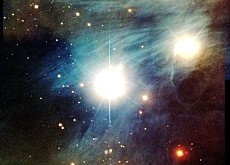planet hunters aim sky high

In 1995 two Swiss astronomers, Michel Mayor and Didier Quéloz, pinpointed the first planet outside our solar system.
Since this momentous discovery, the list of new planets found outside our solar system has continued to grow – thanks in part to the painstaking work of Swiss scientists.
It took people thousands of years to realise that stars were in fact distant suns.
And as telescopes became more powerful, scientists started to observe huge gas clouds in deep space, often in places where only months earlier a star had blazed brightly before disappearing.
By studying the cosmos, crosschecking and making calculations, they finally recognized that stars, like humans, are born and then die.
When stars collapse, solid material is transformed into huge gaseous clouds. These then re-condense to give birth to new stars and planets. That is how scientists believe our solar system was formed 4.6 billion
years ago.
This planet formation theory has been around for the past few decades – but scientists always like to confirm their theories.
The problem is that stars and their planets are light years away, too far for telescopes. Looking for a planet is said to be like looking for an ant on the moon.
Invisible planet
But this is not “mission impossible” for modern science, because even if a planet is invisible, it is possible to spot it by looking for the effect it has on its parent star.
A planet does not rotate around the centre of a star. Both revolve
around the centre of gravity of the planetary system that they create. As a result, a star wobbles rather than moves smoothly.
Seen from the Earth, its speed is not constant either – it either gets closer or moves away. Astronomers call this the Doppler effect, which is when the light of a planet turns bluer when it gets closer and redder when it moves away.
To detect these tiny movements astronomers use incredibly precise optical instruments known as spectrometers.
The discovery made in September 1995 by Mayor and Quéloz from the Geneva Observatory was partly down to good fortune – like many other such astronomical
breakthroughs.
For one year the two astrophysicists pointed the telescope of the Haute Provence Observatory in southern France at the Pegasus constellation searching for brown dwarves – balls of gas between the size of a giant planet and a small star.
Surprises
What they actually found was a planet, located 48 light years away. The new planet, which is 700 times the mass of the Earth, takes around four Earth days to orbit the star 51 Pegasi, and is much closer to it than Mercury is to our Sun.
The most surprising thing was not their long overdue discovery, but
the planet’s characteristics. Most of the 200 new planets found so far resemble huge clouds of gas that revolve quickly and extremely closely around stars, with temperatures up to 1,000 degrees Celsius.
Obviously such worlds are unsuitable for supporting life. But Mayor and many other scientists like him are convinced that if planets result from stars, then life must be a by-product of the planet formation process.
The search therefore goes on for new rocky planets that are the right distance from their suns to allow more favourable temperatures.
One of the most recent discoveries by Mayor’s team is therefore
extremely promising.
The Swiss-led group of scientists has discovered a planetary system made up of three planets, two of which are rocky and approximately 40 times the size of the Earth.
This new system is 40 light years from our universe and contains an asteroid belt similar to the one between Mars and Jupiter.
But to find out more, we have to wait for the launch of new telescopes into space which will go in search of astrophysicists’ “Holy Grail”.
swissinfo, Marc-André Miserez
On October 5, 1995 Swiss astronomers Michel Mayor and Didier Quéloz discovered the first exoplanet using the Haute Provence Observatory telescope in France and the Elodie spectrometer to measure the radial velocity variations of the star 51 Pegasi.
The latest optical instrument, HARPS, can measure minute radial velocity variations of distant stars located several hundred light years away.
Of the 200 new planets discovered to date, almost half have been found by Mayor’s teams, either at the Haute Provence Observatory or at the European Southern Observatory at La Silla in Chile.
The most common way of detecting exoplanets is by measuring radial velocity variations of stars.
The signature of a planet can also be measured via microlensing, monitoring the changes in brightness of a planet when it passes between the star and the Earth.
European and American space agencies will soon launch space telescopes to research exoplanets.

In compliance with the JTI standards
More: SWI swissinfo.ch certified by the Journalism Trust Initiative

You can find an overview of ongoing debates with our journalists here. Please join us!
If you want to start a conversation about a topic raised in this article or want to report factual errors, email us at english@swissinfo.ch.